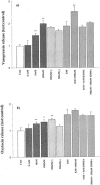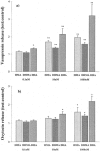The effect of 3,4-methylenedioxymethamphetamine (MDMA, 'ecstasy') and its metabolites on neurohypophysial hormone release from the isolated rat hypothalamus
- PMID: 11834612
- PMCID: PMC1573171
- DOI: 10.1038/sj.bjp.0704502
The effect of 3,4-methylenedioxymethamphetamine (MDMA, 'ecstasy') and its metabolites on neurohypophysial hormone release from the isolated rat hypothalamus
Abstract
Methylenedioxymethamphetamine (MDMA, 'ecstasy'), widely used as a recreational drug, can produce hyponatraemia. The possibility that this could result from stimulation of vasopressin by MDMA or one of its metabolites has been investigated in vitro. Release of both oxytocin and vasopressin from isolated hypothalami obtained from male Wistar rats was determined under basal conditions and following potassium (40 mM) stimulation. The results were compared with those obtained for basal and stimulated release in the presence of MDMA or metabolites in the dose range 1 microM to 100 pM (n=5 - 8) using Student's t-test with Dunnett's correction for multiple comparisons. All compounds tested affected neurohypophysial hormone release, HMMA (4-hydroxy-3-methoxymethamphetamine) and DHA (3,4-dihydroxyamphetamine) being more active than MDMA, and DHMA (3,4-dihydroxymethamphetamine) being the least active. The effect on vasopressin release was greater than that on oxytocin. In the presence of HMMA the ratio test:control for basal release increased for vasopressin from 1.1+/-0.16 to 2.7+/-0.44 (s.e.m., P<0.05) at 10 nM and for oxytocin from 1.0+/-0.05 to 1.6+/-0.12 in the same hypothalami. For MDMA the ratio increased to 1.5+/-0.27 for vasopressin and to 1.28+/-0.04 for oxytocin for 10 nM. MDMA and its metabolites can stimulate both oxytocin and vasopressin release in vitro, the response being dose dependent for each drug with HMMA being the most potent.
Figures







Similar articles
-
Action of MDMA (ecstasy) and its metabolites on arginine vasopressin release.Ann N Y Acad Sci. 2002 Jun;965:399-409. doi: 10.1111/j.1749-6632.2002.tb04181.x. Ann N Y Acad Sci. 2002. PMID: 12105115
-
Examining the role of oxytocin in the interoceptive effects of 3,4-methylenedioxymethamphetamine (MDMA, 'ecstasy') using a drug discrimination paradigm in the rat.Addict Biol. 2011 Apr;16(2):202-14. doi: 10.1111/j.1369-1600.2010.00267.x. Epub 2010 Nov 11. Addict Biol. 2011. PMID: 21070509
-
Melatonin and its analogs inhibit the basal and stimulated release of hypothalamic vasopressin and oxytocin in vitro.Endocrinology. 1993 Mar;132(3):1329-36. doi: 10.1210/endo.132.3.8440190. Endocrinology. 1993. PMID: 8440190
-
3,4-Methylenedioxymethamphetamine (MDMA) as a unique model of serotonin receptor function and serotonin-dopamine interactions.J Pharmacol Exp Ther. 2001 Jun;297(3):846-52. J Pharmacol Exp Ther. 2001. PMID: 11356903 Review.
-
The hypothalamo-neurohypophysial response to melatonin.Neuro Endocrinol Lett. 2001 Jun;22(3):169-74. Neuro Endocrinol Lett. 2001. PMID: 11449194 Review.
Cited by
-
Nephrotoxic effects of common and emerging drugs of abuse.Clin J Am Soc Nephrol. 2014 Nov 7;9(11):1996-2005. doi: 10.2215/CJN.00360114. Epub 2014 Jul 17. Clin J Am Soc Nephrol. 2014. PMID: 25035273 Free PMC article. Review.
-
The entactogen 3,4-methylenedioxymethamphetamine (MDMA; ecstasy) as a treatment aid in psychotherapy and its safety concerns.Arch Toxicol. 2024 Aug;98(8):2409-2427. doi: 10.1007/s00204-024-03765-8. Epub 2024 May 14. Arch Toxicol. 2024. PMID: 38743292 Review.
-
Residual social, memory and oxytocin-related changes in rats following repeated exposure to γ-hydroxybutyrate (GHB), 3,4-methylenedioxymethamphetamine (MDMA) or their combination.Psychopharmacology (Berl). 2010 Dec;212(4):663-74. doi: 10.1007/s00213-010-1986-5. Epub 2010 Aug 21. Psychopharmacology (Berl). 2010. PMID: 20730418
-
Effects of MDMA and related analogs on plasma 5-HT: relevance to 5-HT transporters in blood and brain.Eur J Pharmacol. 2012 Jan 15;674(2-3):337-44. doi: 10.1016/j.ejphar.2011.10.033. Epub 2011 Nov 3. Eur J Pharmacol. 2012. PMID: 22079770 Free PMC article.
-
Ecstacy-associated hyponatremia: why are women at risk?Nephrol Dial Transplant. 2013 Sep;28(9):2206-9. doi: 10.1093/ndt/gft192. Epub 2013 Jun 26. Nephrol Dial Transplant. 2013. PMID: 23804804 Free PMC article. No abstract available.
References
-
- AJAELO I., KOENIG K., SNOEY E. Severe hyponatremia and inappropriate antidiuretic hormone secretion following ecstasy use. Acad. Emerg. Med. 1998;5:839–840. - PubMed
-
- AYUS J.C., WHEELER J.M., ARIEFF A.I. Postoperative hyponatremic encephalopathy in menstruant women. Ann. Intern. Med. 1992;117:891–897. - PubMed
-
- BORGMAN R.J. α-Methyldopamine derivatives. Synthesis and pharmacology. J. Med. Chem. 1974;17:427–430. - PubMed
-
- BECKETT A.H., KIRK G., SHARPEN A.J. The configuration of α-methyldopamine. Tetrahedron. 1965;21:1489–1493.
Publication types
MeSH terms
Substances
LinkOut - more resources
Full Text Sources
Other Literature Sources
Medical

